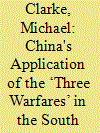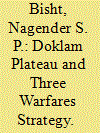| Srl | Item |
| 1 |
ID:
170149


|
|
|
|
|
| Summary/Abstract |
This article explores the development and application of the People’s Republic of China’s
information warfare (IW) strategy to two distinct security challenges: the South China Sea and the
threat of Uyghur terrorism in Xinjiang. The application of China’s IW strategy in the South China
Sea dispute demonstrates that, in contrast to Western understandings whereby IW is seen as an adjunct
to more kinetic strategies of conflict, China’s conception of IW is not just relevant in times of conflict
or crisis, but applicable across the peacetime-crisis-war spectrum. The application of aspects of the
“three warfares” in Xinjiang meanwhile demonstrates China’s blurring of the lines between “national
security” and “regime security.”
|
|
|
|
|
|
|
|
|
|
|
|
|
|
|
|
| 2 |
ID:
169952


|
|
|
|
|
| Summary/Abstract |
India-China border has not been formally demarcated and there are areas where both sides have differing perception of Line of Actual Control (LAC), and its perception on ground have led to a number of skirmishes and standoffs, Doklam being the most recent. The differentiating factor in this standoff was that it took place in a third country, Bhutan. This crisis will remain an important indicator of Indian and Chinese strategic behaviour in any future crisis between the two emerging powers. This will also reflect on India’s relations with other countries in South Asia and vice versa. A major aspect of Indian strategic behaviour that emerged from this crisis was that India can play the game of military brinkmanship and win it.
|
|
|
|
|
|
|
|
|
|
|
|
|
|
|
|
| 3 |
ID:
183138


|
|
|
|
|
| Summary/Abstract |
This article traces the evolution of the Communist Party of China’ policy towards Taiwan and identifies the major characteristics of different leaderships in the history of CPC. With the major goal to manipulate the domestic politics of Taiwan to prevent it from moving further towards independence, the CPC has, within the framework of national strategy, used the carrot (promised benefits or attraction based on positive values), the stick (military actions or threats, blockades and coercive policies in international politics, etc.), the net (relationships, networks and United Front work; developing local collaborators) and the needle (infiltration, sabotage and disinformation warfare) interchangeably with different emphases depending on the strategic environments it faced. The CPC’s policy towards Taiwan, thus demonstrates flexibility in the choice of tactics but remains constant in its strategic goals.
|
|
|
|
|
|
|
|
|
|
|
|
|
|
|
|